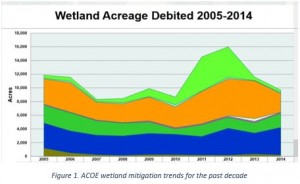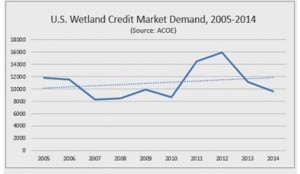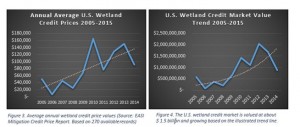28 June 2008 | Adolph Feyereisen thought he knew all the ways to farm his 1040 acres in Emmons County, North Dakota. He’d taken over a dairy operation from his father in the 1960s, ran that until 1975, and then raised beef for a decade before dropping that to become a crop adjuster. Now that he’s semi-retired, he’s back to beef, along with small grains like barley and wheat.
But his latest cash crop is novel to the agricultural economy of the plains: sequestered carbon.
Last January, conservation group Ducks Unlimited purchased both a perpetual easement on Feyereisen’s native grassland and the rights to the carbon stored under that 272 acres. DU then passed the easement along to the Fish & Wildlife Service, but is bundling Feyereisen’s carbon with the carbon from scores of other North Dakota landholders and selling it on the open market, perhaps to a corporation in search of a significant carbon offset.
The short-term plan is to invest the proceeds from the carbon market in new habitat protection in the plains states. Then, if that works out, DU could take its 11.5-million-acre track record of habitat restoration and turn it into a revenue-generating portfolio to accelerate its conservation work.
For some of the most important and threatened waterfowl habitat in North America, the plan comes just in time.
The Brokers
“These are some of the best credits I’ve ever seen or been a part of,” says Radha Kuppalli of New Forests, a Sydney-based company helping to broker the deal.
Better known for forest management, New Forests is working with Equator Environmental, LLC to package the DU carbon for the voluntary carbon market. Equator provides financing to help fund carbon purchases, and will sell the credits to investors looking to downsize their carbon footprint. Equator and New Forests will work together to ensure that the credits meet high standards.
“Every single element that you can think of in a carbon project — additionality, quantification protocols, leakage, permanence — everything that you need to address is here,” says Kuppalli. “There is such an enormous biodiversity component.”
To Farm or Not to Farm
That’s precisely DU’s interest. Feyereisen’s 272 acres is native prairie, never tilled because it’s quite rocky and hilly. It’s also pocked with glacial potholes — shallow, watery depressions left by the glaciers. He’s never planned to plow it, but that doesn’t mean it can’t be done.
“They just have to rip the rock out,” says Feyereisen. “The equipment they’ve got now, it doesn’t take much. To say land can’t be farmed in this day and age, the way technology is going, that’s probably a pretty far-fetched statement.”
Abundance of Birds
Before the advent of European settlers, the Prairie Pothole Region in the Dakotas was at the heart of the world’s largest grassland, the Great Plains of North America. Feyereisen’s potholes are just a few of the millions of glacial potholes that cover some 100,000 square miles, harboring rich stores of aquatic plants and animals. Pintails, mallards, gadwall, blue-winged teal, shovelers, canvasbacks—each spring millions of ducks nest in the grasslands adjoining the potholes. Many other birds—lesser scaup, wigeon, green-winged teal, Canada geese and snow geese—use the area as a staging ground in their migration to the boreal north.
These fowl riches brought DU to the region almost at its inception, beginning habitat restoration in the adjacent Canadian portion as early as 1938. Since then, the organization has done restoration work on 11.5 million acres throughout much of the United States. But the potholes remain a priority: DU considers the area the most important and threatened waterfowl habitat in North America. Agriculture has already destroyed or altered more than half of the potholes. And climate change is the new threat on the horizon; the Wildlife Society projects a loss of as much as 90% of U.S. wetlands by 2080.
Competing Interests
Meanwhile, agricultural pressures are building. Ironically, climate concern has helped heat up the biofuels sector, putting further pressure on food prices that were already being ratcheted up by rising petroleum prices and natural disasters. Vagaries in federal agricultural policy are also having an impact. The Conservation Reserve Program (CRP), which rewards farmers for converting highly erodible cropland to grass, has been unable to compete with the hot ag land market as the 10 to 15 year contracts have expired. Almost 420,000 acres of North Dakota CRP land — more than 12 percent of the state’s total — were lost back to cropland in 2007 alone.
Federal ability to do conservation work in North Dakota is abridged as well; a political backlash against federal lands resulted in legislative veto power over the expenditure of federal duck stamp money to purchase habitat in the state. That leaves the private sector.
“Wildlife belongs to the public, yet private property – and therefore private landowners – really have all the habitat, so you have to work with them,” explains Jim Ringelman, DU’s Director of Conservation Programs for the Dakotas and Montana. DU has been working with private landowners for decades, developing tools and credibility.
Underground Carbon
Its carbon work began a couple of years ago, as the voluntary carbon market was beginning to solidify. While the carbon storage potential of forests rises in plain site, grasslands hide their carbon underground. Prairie plants sink deep roots five to nine feet into the plains, stockpiling carbon away from the oxidizing forces that would release it into the atmosphere. The Agricultural Research Service already had some local data on sequestration potential. With support from the Plains CO2 Reduction (PCOR) Partnership, DU worked with soil scientist Larry Cihacek of North Dakota State University to measure carbon stores under native prairies and restored grasslands.
It was an ideal research situation: Grasslands restored under the conservation reserve program range in age from a couple of years to 20 years.
“We could sample in one or two years a huge range of vintages,” explains Ringelman.
DU research shows that the north plains grassland sequester an average of 1.485 tons* of CO2 equivalent per acre per year. And while forest types in DU’s restoration portfolio can put away three to six times that, the acreage of the grassland resource is large enough to make it a potentially major player.
Adding Above and Below
Enter the US Fish & Wildlife Service, whose Grassland Easement program operates in the Prairie Pothole Region with a short budget and a backlog of interested participants. DU’s plan is to buy perpetual grassland easements and carbon credits at the same time. The easements are passed on to the FWS, and the carbon credits are bundled and resold to finance more conservation.
“It keeps the land in the private landowners’ hands,” explains Tammy Fairbanks of the FWS. “It doesn’t change their use on the property. They can still graze it, hay it, and get an income off it, and they pay taxes on it. The government does not have an operation and maintenance cost on that property. So we have the habitat protection, but we don’t have the cost of managing it.”
The DU assistance also cuts down on the FWS backlog, protecting habitat in imminent danger—the pothole counties of North Dakota alone have lost 88,000 acres of native prairie since 2002.
Meager Resources
“We need resources in the order of many tens of millions if not hundreds of millions to do what we need to get done,” adds Ringelman. “We have no hope of getting that through the traditional sources – the duck stamp money. This is big potential for us to accelerate our work. It’s revenue of the order of magnitude that we think is necessary to really make the kind of conservation footprint that we need to have to save the critical habitats. And it comes at an ideal time because current crop prices are putting a whole new set of pressures on grasslands.”
All the Ingredients
A number of elements make the DU plan exciting, beginning with the federal foundation.
“Having a perpetual easement held and monitored and enforced by the US Fish and Wildlife Service is extremely valuable,” says Kuppalli. “You’ve got the federal government backing your product. It’s really enabling. If you’re investing in carbon, or you’re a carbon buyer, you have to choose between a perpetual easement helped by a lands trust versus one held by the federal government?”
But while a federal program enables the project, Kuppalli is also quick to point out that federal programs and subsidies for corn and other commodities create countervailing forces.
The private element is important too, argues Dick Kempka, who spent years developing GIS technology for DU before jumping recently to Equator as vice president of sales.
“Seventy percent of the opportunity in the ecological asset market will be on private land,” he says. “If you can’t work on private land, you’re probably not going to be a big player in this arena.”
Incorporating grassland into the voluntary carbon market is another coup.
“Whatever business you’re in, you want to have a diversified portfolio,” he says. “There is a lot of benefit to restoring grassland and having tonnage be available right away, in a market where most feel there will be an annualized accounting.”
Then there is the Ducks Unlimited brand.
“That’s the big selling point,” he argues. “The social benefits associated with offsets are much better than any type of geologic sequestration, or methane capture. The bottom line is if I’m a pre-compliant utility, or a carbon-neutral socially responsible type of investor, these types of offsets very much fit the bill because they’re going to get other benefits from it – whether they’re explicit or implicit.”
Rethinking Agricultural Value
Ringelman hopes to change the very definition of agricultural value in the plains.
“There is a notion here that we have to pump up the economy of the state, and that grassland – particularly native prairie – is just a land cover that’s waiting for a higher and better use to come along,” he says. “Now we have a chance through this carbon work to show them that look, there’s more to this land. It’s more than just cutting hay and running cows on it. You’re also sequestering carbon. You’re doing a lot of things that people are going to start paying for, so let’s hold on to this here and take another look at it.”
DU plans to keep pushing the ecosystem services envelope, looking at water quality and possibly biodiversity offsets as well.
Exploring Biodiversity Offsets
“What we do with restoring wetlands has big water quality benefits. I think that’s not very far off,” says Ringelman. “Biodiversity is a little bit funkier.”
Funky, but not far-fetched. Birds traverse North America from key breeding areas like the prairie pothole to wintering areas. And populations are often limited by what happens on the breeding grounds. The Henslow’s sparrow, for example, breeds in the plains grasslands, but winters to the south, often in populated coastal areas.
“Maybe the time’s not far off that when someone does a project that’s affecting wintering habitat and sparrows down there, they’ll be coming to us (because) we can really have a population affect working with on this end of the flyway,” says Ringelman.
Feyereisen thinks a little more down to earth.
“My kids are willing to leave it like it is, and I would hope it would be like it is,” he says. “If I want to be selfish about it, this is one way to make sure it is.”
![]()
Erik Ness writes about science and the environment from Madison, Wisconsin. You can reach him through his website, www.erikness.com.
Please see our Reprint Guidelines for details on republishing our articles.
* The initial posting of this story misstated the figure as 1.485 million tons. We regret the error.









